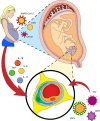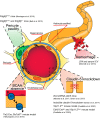Neurological consequences of neurovascular unit and brain vasculature damages: potential risks for pregnancy infections and COVID-19-babies
- PMID: 33998773
- PMCID: PMC8237015
- DOI: 10.1111/febs.16020
Neurological consequences of neurovascular unit and brain vasculature damages: potential risks for pregnancy infections and COVID-19-babies
Abstract
Intragravidic and perinatal infections, acting through either direct viral effect or immune-mediated responses, are recognized causes of liability for neurodevelopmental disorders in the progeny. The large amounts of epidemiological data and the wealth of information deriving from animal models of gestational infections have contributed to delineate, in the last years, possible underpinning mechanisms for this phenomenon, including defects in neuronal migration, impaired spine and synaptic development, and altered activation of microglia. Recently, dysfunctions of the neurovascular unit and anomalies of the brain vasculature have unexpectedly emerged as potential causes at the origin of behavioral abnormalities and psychiatric disorders consequent to prenatal and perinatal infections. This review aims to discuss the up-to-date literature evidence pointing to the neurovascular unit and brain vasculature damages as the etiological mechanisms in neurodevelopmental syndromes. We focus on the inflammatory events consequent to intragravidic viral infections as well as on the direct viral effects as the potential primary triggers. These authors hope that a timely review of the literature will help to envision promising research directions, also relevant for the present and future COVID-19 longitudinal studies.
Keywords: COVID-19; blood-brain barrier; cytokines; hemorrhage; inflammation; long-COVID; maternal immune activation; neurovascular unit; prenatal viral infection; synapse.
© 2021 Federation of European Biochemical Societies.
Conflict of interest statement
The authors declare no conflict of interest.
Figures


Similar articles
-
The neurodevelopmental impact of prenatal infections at different times of pregnancy: the earlier the worse?Neuroscientist. 2007 Jun;13(3):241-56. doi: 10.1177/1073858406296401. Neuroscientist. 2007. PMID: 17519367 Review.
-
Prenatal poly(i:C) exposure and other developmental immune activation models in rodent systems.Biol Psychiatry. 2014 Feb 15;75(4):307-15. doi: 10.1016/j.biopsych.2013.07.011. Epub 2013 Aug 12. Biol Psychiatry. 2014. PMID: 23938317 Review.
-
In-vivo rodent models for the experimental investigation of prenatal immune activation effects in neurodevelopmental brain disorders.Neurosci Biobehav Rev. 2009 Jul;33(7):1061-79. doi: 10.1016/j.neubiorev.2009.05.001. Epub 2009 May 12. Neurosci Biobehav Rev. 2009. PMID: 19442688 Review.
-
Prenatal maternal immune activation and brain development with relevance to psychiatric disorders.Neuroscience. 2017 Mar 27;346:403-408. doi: 10.1016/j.neuroscience.2017.01.033. Epub 2017 Jan 31. Neuroscience. 2017. PMID: 28153689
-
Prenatal Immune and Endocrine Modulators of Offspring's Brain Development and Cognitive Functions Later in Life.Front Immunol. 2018 Sep 26;9:2186. doi: 10.3389/fimmu.2018.02186. eCollection 2018. Front Immunol. 2018. PMID: 30319639 Free PMC article. Review.
Cited by
-
Prenatal SARS-CoV-2 Spike Protein Exposure Induces Autism-Like Neurobehavioral Changes in Male Neonatal Rats.J Neuroimmune Pharmacol. 2023 Dec;18(4):573-591. doi: 10.1007/s11481-023-10089-4. Epub 2023 Oct 27. J Neuroimmune Pharmacol. 2023. PMID: 37889404
-
Exploring the Link between Maternal Hematological Disorders during Pregnancy and Neurological Development in Newborns: Mixed Cohort Study.Life (Basel). 2023 Oct 5;13(10):2014. doi: 10.3390/life13102014. Life (Basel). 2023. PMID: 37895395 Free PMC article.
-
Intrauterine inflammation and postnatal intravenous dopamine alter the neurovascular unit in preterm newborn lambs.J Neuroinflammation. 2024 May 28;21(1):142. doi: 10.1186/s12974-024-03137-0. J Neuroinflammation. 2024. PMID: 38807204 Free PMC article.
-
Predicting perinatal outcomes in women affected by COVID-19: An artificial intelligence (AI) approach.J Med Life. 2023 Sep;16(9):1421-1427. doi: 10.25122/jml-2023-0214. J Med Life. 2023. PMID: 38107716 Free PMC article.
-
Transplacental SARS-CoV-2 protein ORF8 binds to complement C1q to trigger fetal inflammation.EMBO J. 2024 Nov;43(22):5494-5529. doi: 10.1038/s44318-024-00260-9. Epub 2024 Oct 10. EMBO J. 2024. PMID: 39390219 Free PMC article.
References
-
- Stein AD & Lumey LH (2000) The relationship between maternal and offspring birth weights after maternal prenatal famine exposure: the Dutch Famine Birth Cohort Study. Hum Biol 72, 641–654. - PubMed
-
- Torrey EF, Miller J, Rawlings R & Yolken RH (1997) Seasonality of births in schizophrenia and bipolar disorder: a review of the literature. Schizophr Res 28, 1–38. - PubMed
Publication types
MeSH terms
LinkOut - more resources
Full Text Sources
Other Literature Sources
Medical

